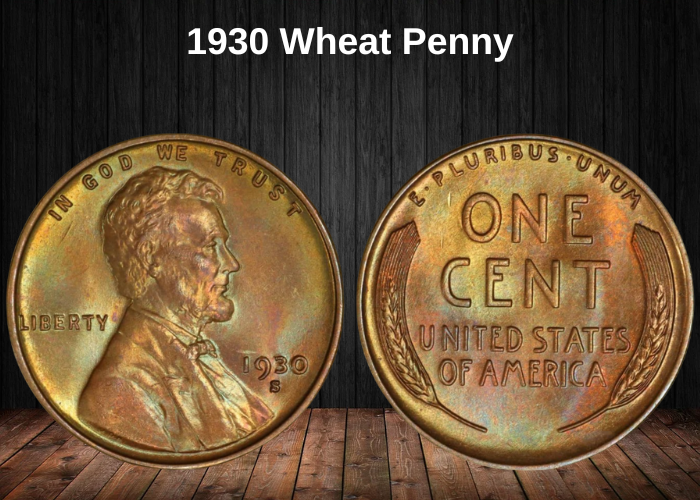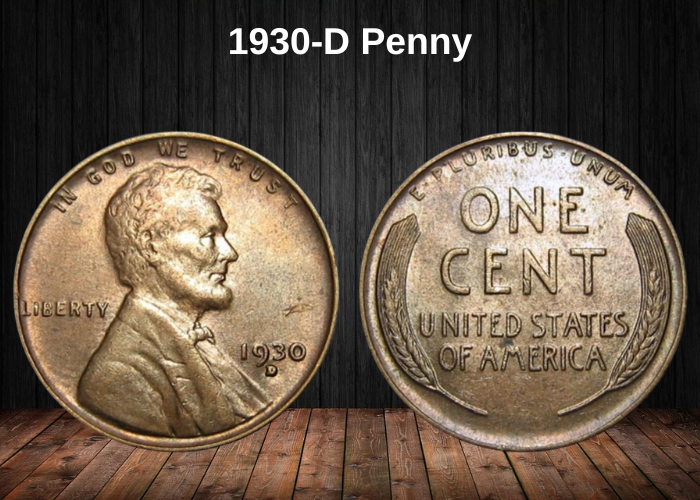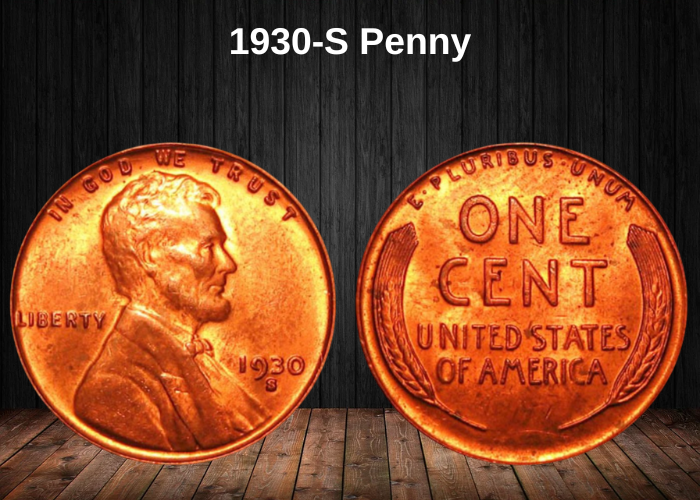
Did you know your 1930 wheat penny could be worth far more than its face value — possibly even hundreds of dollars?
If you’ve stumbled upon one in your pocket change or inherited a small coin collection, you might be wondering: Is this penny rare? Could it be valuable?
In this guide, we’ll help you uncover the hidden potential of your 1930 Lincoln cent by answering the most important questions, like:
- 🪙 What’s the real value of a 1930 penny?
- 🔍 What makes certain 1930 wheat pennies so rare and collectible?
- 🏭 How many of these coins were minted?
- ⚠️ What kinds of errors should you be looking for?
- 👨🎨 And who was the talented artist behind the Lincoln cent design?
Let’s dig into the fascinating world of 1930 wheat pennies and help you figure out whether you’ve got a common coin — or a rare and valuable treasure.
What Factors Influence The Value Of A 1930 Penny?
If you’re curious about how much your 1930 Lincoln cent might be worth, there are three key factors to consider:
1. The Coin’s Condition (or Grade)
The state of your coin plays a huge role in determining its value. A heavily worn penny that’s been in circulation for decades will be worth less than one that’s still sharp, clean, and uncirculated.
Collectors use a grading scale to assess coins — ranging from heavily worn (Good) to flawless (Mint State). There are plenty of grading guides online to help you figure out where your coin stands.
2. The Mint It Came From
Not all 1930 pennies were struck at the same place. That year, the U.S. Mint produced pennies at three different facilities:
- Philadelphia (no mintmark)
- Denver (marked with a D)
- San Francisco (marked with an S)
To find the mintmark on a Lincoln cent, just look just below the date on the obverse (front) of the coin. If there’s no letter there, your penny came from Philadelphia.
3. Errors or Special Varieties
Some 1930 wheat pennies are worth a lot more than others — not because of their condition or rarity, but due to minting mistakes! These error coins or unusual varieties are highly sought after by collectors.
We’ll cover the most common 1930 penny errors and their values a bit later in this article — so stay tuned!
How Much Is a 1930 Wheat Penny Worth Today?
If you’re wondering what your 1930 penny is worth, you’re in the right place. Let’s break it down by type and condition:
🔸 1930 Penny Value (No Mintmark – Philadelphia)
The most common 1930 Lincoln cent is the one minted in Philadelphia, which doesn’t carry a mintmark.
- In circulated condition, these typically sell for $0.07 to $0.25.
- Uncirculated examples can bring $20 or more, especially if they still have their original red luster.
💎 Record Sale: A 1930 penny graded MS-67 Red by PCGS sold for $10,925 in 2005.
🔸 1930-D Penny Value (Denver Mint)

The Denver-minted coin carries a small D under the date and is less common than the Philadelphia version.
- Circulated coins are valued around $0.10 to $0.50.
- Mint State examples can fetch $15 and up.
💎 Record Sale: The highest-known sale was $11,400 for an MS-67 Red specimen in 2019.
🔸 1930-S Penny Value (San Francisco Mint)

If your coin has an S mintmark, it came from San Francisco. These are also quite collectible in high grades.
- In circulated condition, expect $0.40 to $1.50.
- Uncirculated pieces can start at $15 or more, with high premiums for red luster.
💎 Record Sale: A 1930-S Lincoln cent graded MS-67 Red by PCGS sold for a stunning $33,350 in 2004.
What Is The Grade Of Your 1930 Penny?
Why Are Some 1930 Pennies Considered Rare?
While most U.S. pennies are quite common, certain ones—like specific 1930 Lincoln cents—can be genuinely rare and highly valuable.
So, are 1930 pennies rare?
👉 In general, no—most 1930 pennies you’ll come across are not rare. Over 200 million were minted across the Philadelphia, Denver, and San Francisco Mints that year. That’s a huge number, which means circulated examples are still found today and usually only worth a few cents.
But rarity isn’t always about how many were minted. It’s also about how many have survived in exceptional condition.
What Makes a 1930 Penny Rare?
- Top-Grade Condition: Very few 1930 pennies have survived in pristine, mint-state condition with full red color and strong strikes. These are highly sought after by collectors.
- Mint Errors & Varieties: Some 1930 wheat pennies display rare errors like doubled dies, re-punched mintmarks, or off-center strikes. These mistakes make the coin stand out—and that boosts value and rarity.
So, while most 1930 pennies are common, those in gem condition or with minting errors can be quite rare… and worth hundreds or even thousands of dollars!
A List Of Rare 1930 Penny Errors… And Their Values
1930 Doubled Die Penny Error
You may have heard of doubled die coins — they’re a popular and intriguing mint error among collectors.
This type of error occurs during the die creation process. Specifically, a doubled die happens when the die (which stamps the coin’s design) is accidentally impressed more than once and at slightly different angles by the hub, resulting in a noticeable doubling effect on the coins it later strikes.
👉 Important note: They’re called “doubled dies”, not “double dies.”
Coins struck from these flawed dies can show visible doubling on features like letters, numbers, or other design elements. Some doubled die coins are extremely rare and can sell for thousands of dollars, depending on the coin and the clarity of the doubling.
As for 1930 Lincoln cents, there are currently no major or widely known doubled die varieties. However, if you do happen to find one with obvious doubling visible to the naked eye, you could be holding something very rare.
✅ Estimated Value: A verified 1930 doubled die penny with strong doubling could easily sell for $100 to $500 or more, depending on its condition and the prominence of the error.
So, keep your eyes peeled — discovering one could be your lucky break!
1930 Off-Center Penny Error
Another notable type of mint error is the off-center strike — this happens when the blank coin (called a planchet) isn’t properly aligned during the minting process.
As a result, only part of the design is struck onto the coin, while the rest is missing or appears off the edge. The unstruck area will usually look smooth or blank.
💡 The value of off-center errors often depends on how far off the strike is. Generally, the more off-center the coin is, the more valuable it becomes — as long as the full date and mintmark are still visible, which is crucial for collectors.
➡️ Estimated Value: Off-center 1930 pennies with clear dates can be worth over $150, especially if the strike is significantly misaligned (like 50% or more off-center).
1930 Penny With Missing Letters Error
You wouldn’t believe how often people message me about strange or missing letters and numbers on their coins!
In most cases, these oddities turn out to be post-mint damage — things like scratches, dents, or dings that just look like letters or numbers. Other times, people have manually stamped or carved letters onto a coin after it left the Mint.
However, in some cases, the missing or distorted letters are due to actual mint errors. These occur when a coin is struck by a damaged die or one that had debris, grease, or even cloth fibers stuck to it. This prevents certain parts of the design from fully transferring onto the coin, causing letters or phrases to appear faint or completely missing.
➡️ These are called strike-through errors, and they’re fairly well-known among collectors. If you have a 1930 penny with obvious missing letters caused by this type of minting error — not damage — it could be worth anywhere from $100 to $250 or more, depending on severity and visibility.
1930 Penny With Die Break, Die Crack, or Cud Error
If you spot a raised line or crack running across part (or even all) of your 1930 penny, you might be looking at a die crack — a common error that happens when the die used to strike the coin begins to break down from excessive use.
There are several types of die-related errors:
- Die Cracks – thin raised lines caused by fractures in the die.
- Die Chips – small blobs or bumps from minor breaks in the die.
- Cuds – larger raised areas connected to the coin’s rim, where a piece of the die broke off entirely.
These kinds of errors are popular among collectors, though values can vary depending on size, location, and visibility of the break.
💰 Value estimate:
- Small or minor die cracks: $10 to $25
- Large, dramatic cracks or cuds: $100 to over $250, especially if they’re eye-catching or unusual.
Other Types of Errors You Can Find on 1930 Pennies
Here are a few more errors you might come across on 1930 pennies:
- Lamination Errors
These happen when parts of the coin’s surface flake off due to chemical impurities in the metal. Lamination errors usually have a value of around $10 to $25. - Broadstrikes
Broadstrikes occur when a coin isn’t struck inside its retaining collar, which is meant to shape the rim and keep the coin at the correct size. Coins with this error often sell for $50 and up, depending on the size and prominence of the mistake. - Clipped Planchet
Clipped planchets are common and occur when a small part of the coin is cut off during the minting process. These errors are usually worth $5 to $10 for a circulated 1930 Lincoln cent with a clipped planchet.
These types of errors can make a 1930 penny even more interesting to collectors!
Interesting Facts About 1930 Pennies
Here are some cool facts about 1930 pennies that you can share with your friends and family:
- Mintage Breakdown
More than 200 million pennies were minted in 1930. Here’s how they were distributed across the mints:- Philadelphia Mint: 157,415,000
- Denver Mint: 40,100,000
- San Francisco Mint: 24,286,000
- Who Designed the 1930 Penny?
The designer of the 1930 penny was Victor David Brenner, the same artist who created the original Lincoln cent design. His VDB initials can be found in very tiny script under Lincoln’s shoulder on the obverse (front) of the coin.
These little nuggets of trivia add even more value to these historic pennies!
Where to sell your penny?
Now that you know the value of your penny, you might be wondering where to sell it. Don’t worry: here’s a guide to some of the best online platforms where you can easily sell your coins, along with their advantages and disadvantages.
Discover the best platforms for selling coins online (pros and cons).
FAQ
1. Why is the 1930 Wheat Penny important in the context of the Great Depression era?
The 1930 Wheat Penny was minted during the Great Depression, a period of severe economic hardship following the stock market crash of 1929. The economic turmoil led to a reduction in coin production, with lower mintages compared to earlier years. The 1930 penny, as part of the post-crash currency, represents an important piece of the United States’ numismatic history during a time of major financial crisis.
2. How does the 1930 Wheat Penny compare to other years in terms of mintage and rarity?
The 1930 Wheat Penny had a mintage of 134,028,000 coins, which is relatively high but not as large as some earlier years in the 1920s. Despite the large mintage, the 1930 penny remains less common in high-grade, uncirculated examples, making well-preserved coins more desirable to collectors. The overall supply of 1930 pennies is higher, but high-grade specimens are more scarce.
3. What makes the 1930-S Wheat Penny more valuable than the 1930 Philadelphia and Denver issues?
The 1930-S Wheat Penny, minted in San Francisco, had a much lower mintage of just 4,434,000 coins, making it significantly rarer than the 1930 Philadelphia and 1930-D issues. Coins in higher grades, especially those in MS64 or MS65, are especially valuable due to their scarcity, and the 1930-S penny is highly sought after by collectors for its rarity in top condition.
4. How does the condition of a 1930 Wheat Penny impact its market value?
The condition of a 1930 Wheat Penny plays a crucial role in determining its value. Well-preserved coins, especially those in uncirculated grades like MS64 or higher, fetch much higher prices than those in lower grades. Red (RD) examples are more desirable than those with brown (BN) or red-brown (RB) toning, and uncirculated coins that retain sharp details and original luster are especially prized by collectors.
5. Are there any notable die varieties or errors in the 1930 Wheat Penny series?
While the 1930 Wheat Penny is not known for significant errors or varieties, like die cracks, off-center strikes, and double die errors can occasionally appear. Some 1930 coins, especially those from the San Francisco Mint, show weaker strikes, which can make finding well-preserved specimens in high grades more difficult. These minor errors and die variations can be of interest to error coin collectors, although they do not significantly affect the overall value.
6. What role did the economy and the state of coinage production in the early 1930s play in the creation of the 1930 Wheat Penny?
During the early 1930s, coinage production in the U.S. saw a reduction due to the Great Depression. Minting operations slowed down, and the U.S. Mint faced economic constraints. This situation led to a reduction in overall coin production, with fewer coins being made for circulation and some coins being stored for later use. The 1930 Wheat Penny represents this period of transition, where production volumes were lower compared to previous years, making higher-grade examples relatively more scarce.
7. How has the 1930 Wheat Penny’s market value evolved over the years, and what does this mean for collectors?
The value of the 1930 Wheat Penny has fluctuated over the years as demand and collector interest have changed. While the 1930 Philadelphia penny is relatively common, the 1930-S penny has seen significant growth in value, especially in uncirculated grades. For collectors, this means that acquiring higher-grade 1930-S coins can be a good investment opportunity, as their scarcity in top condition is likely to result in gradual appreciation over time. As interest in high-quality vintage coins grows, the potential for further price increases remains strong for rare and well-preserved specimens.



















































